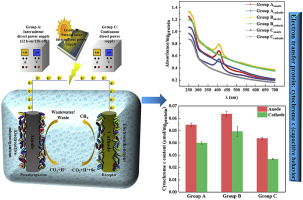Water Research ( IF 11.4 ) Pub Date : 2020-03-09 , DOI: 10.1016/j.watres.2020.115696 Bo Wang , Wenzong Liu , Yifeng Zhang , Aijie Wang

|
Electroactive microorganisms (EAMs) can act as pseudocapacitor to store energy and discharge electrons on need, while electromethanogens acting as receptor are able to utilize electrons, protons and carbon dioxide for methanization. However, external energy is required to overcome thermodynamical barriers for electromethanogenesis. Herein, electro-driving power by solar light was established to accelerate conversion of waste organics to bioenergy. The intermittent power supply modes were elucidated for favourable performances (e.g., current density, methane production rate, energy recovery efficiencies and economic evaluation), compared with the control driven by continuous applied voltage. It was found that natural intermittent solar-powered mode was more beneficial for microorganisms involved in electron transfer and energy recovery than manual sharp on-off mode. Electrochemistry analysis unrevealed that a higher redox current and lower resistance were exhibited under the solar-powered mode. A high charge storage capacity and electron mobility were found through cytochrome c content and live cells ratio in the solar-power assisted bioreactor. The intermittent power driving modes can regulate electron transfer proteins with capacitive storage behavior in biomass, which helps to understand the responses of functional communities on the stress of intermittent electric field. These findings indicate a promising perspective of microbial biotechnology driven by solar power to boost bioenergy recovery from waste/wastewater.
中文翻译:

太阳能加速废水中的生物能源回收:间歇性电驱动调节和生物质中的电容性存储
电活性微生物(EAM)可以充当伪电容器来存储能量并在需要时释放电子,而充当受体的电甲烷可以利用电子,质子和二氧化碳进行甲烷化。然而,需要外部能量来克服用于电甲烷形成的热力学障碍。在本文中,建立了利用太阳能的电驱动动力以加速将废有机物转化为生物能。与由连续施加电压驱动的控制相比,阐明了间歇电源模式具有良好的性能(例如,电流密度,甲烷产生率,能量回收效率和经济评估)。发现自然间歇太阳能模式对参与电子转移和能量回收的微生物比手动快速开关模式更有利。电化学分析表明,在太阳能模式下,氧化还原电流较高,电阻较低。通过细胞色素发现高电荷存储容量和电子迁移率太阳能辅助生物反应器中的c含量和活细胞比率。间歇性动力驱动模式可以调节生物质中具有电容性存储行为的电子转移蛋白,这有助于了解功能性社区对间歇性电场应力的响应。这些发现表明了由太阳能驱动的微生物生物技术的前景广阔,以促进从废物/废水中回收生物能源。










































 京公网安备 11010802027423号
京公网安备 11010802027423号